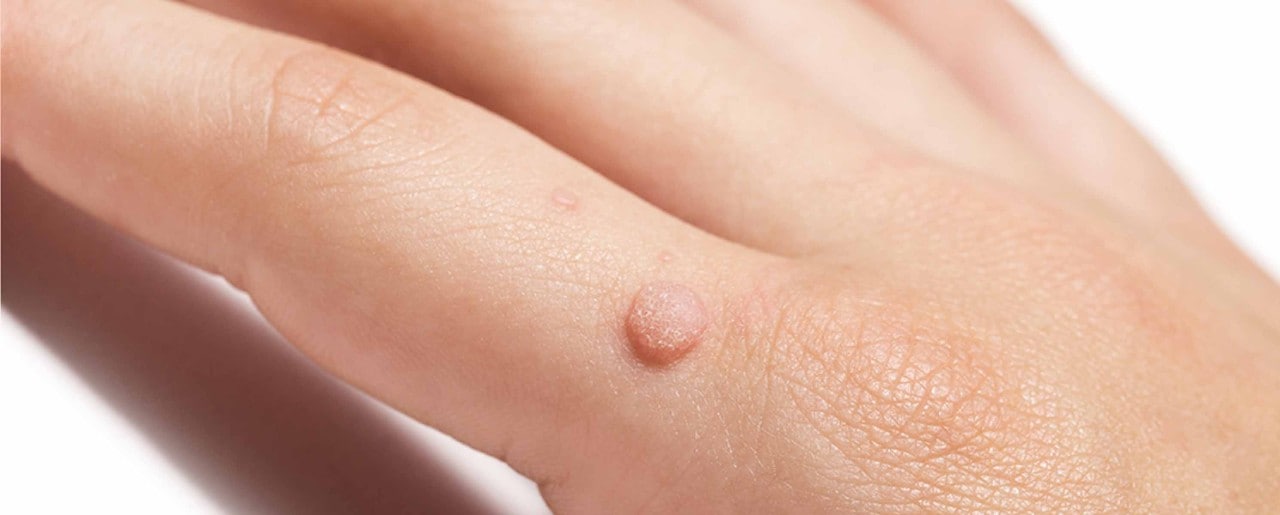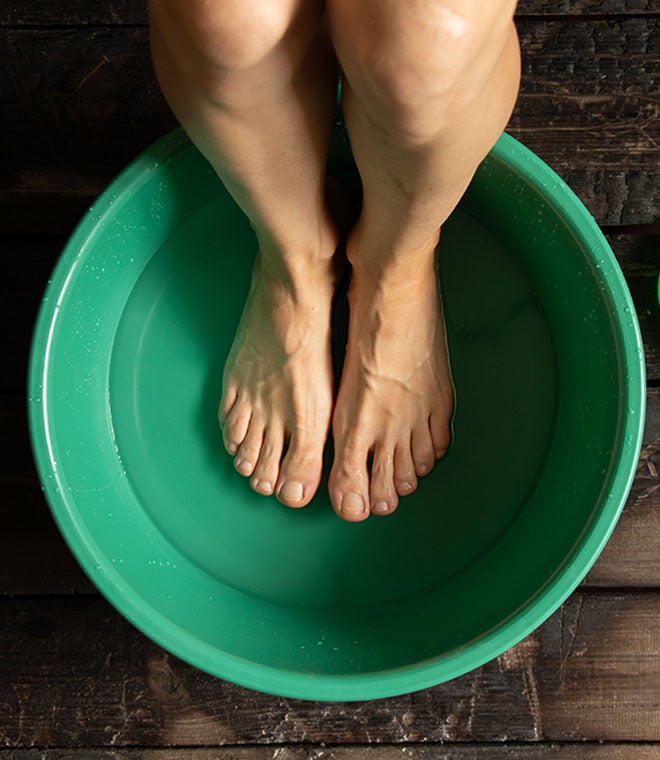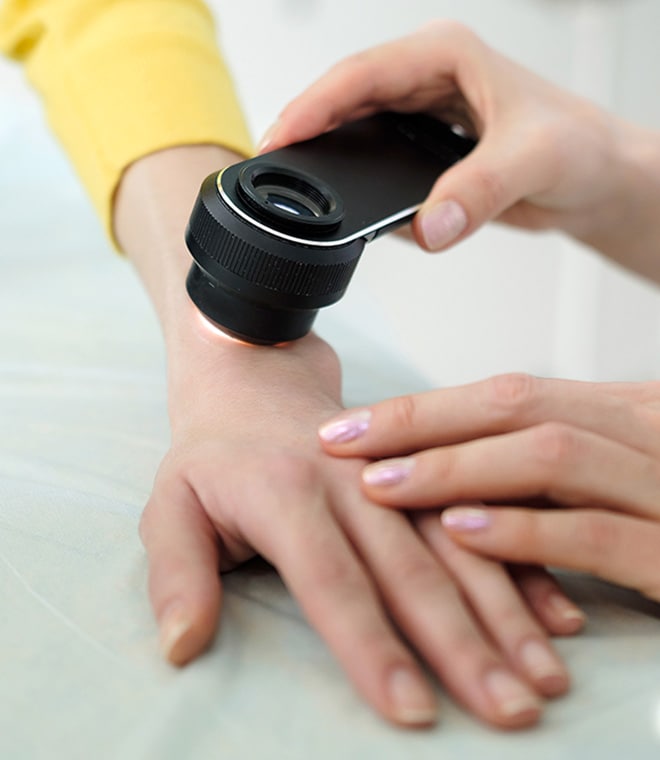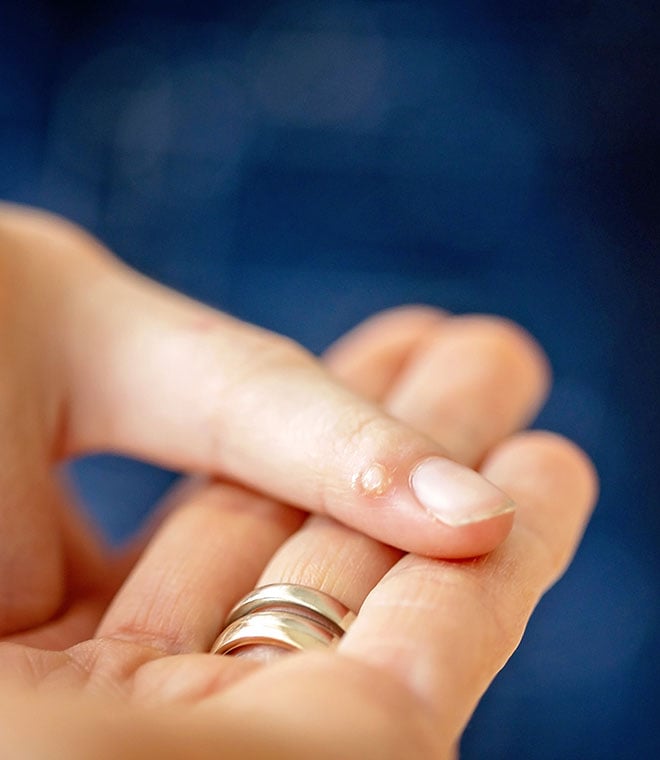Health
Warts on the hands: Causes, symptoms and treatments
By Anna H. Chacon, MD, Fellow of the American Academy of Dermatology Jun 19, 2024 • 8 min
A wart that occurs on the hands or fingers is usually a common wart or a palmar wart, depending on its location and if it’s sunken or protruding. Children and teenagers are more likely than adults to have common warts, but anyone of any age can get them. While warts aren’t dangerous, they can be unsightly, bothersome or, in some cases, downright painful. The good news is that there are effective treatments for warts on the hands.
What causes a wart on a finger or the hand?
All types of warts, including common warts on fingers and hands, are caused by several types of the human papillomavirus, or HPV. The virus enters through small cuts in your skin and causes an overgrowth of cells. This makes the outer layer of the skin turn thick and hard, and a round shaped wart eventually forms.
Types of warts on the hands
True to their name, common warts are very common — most people will develop a wart in their lifetime. But they’re not the only types of warts on the hands. Flat warts may also occur on the hands or fingers, although they’re more common on the face. Palmar warts can be more painful and difficult to treat.
Symptoms of common warts and flat warts
Common warts on the palm, back of the hands, knuckles and fingers range in size from the diameter of a pinhead to the size of a pea. They appear as a grayish-brown, dome-shaped growth that’s hard and rough. Common warts may have black dots on the surface, which are actually clotted blood vessels.
Flat warts are very small, about the size of a pinhead. They’re smooth rather than rough, slightly raised and have a flat top. They may be pink, yellow or light brown in color.
Flat warts and common warts can appear in clusters ranging from a few warts to a large number. These are known as mosaic warts.
Should you have common warts removed?
It isn’t necessary to remove common warts since they’re almost always harmless and they generally go away on their own. However, it can take anywhere from a few weeks to a couple of years or longer for them to go away. If you have warts on your hands but they’re not bothersome, it’s fine to leave them alone and let them run their course.
However, a common wart can become painful, depending on where it’s located. Warts on the knuckles may knock against hard surfaces during routine tasks, causing pain or injury. Warts on the palm may cause discomfort if you work with your hands. Common warts on a finger may rub painfully against an object like a pencil, while flat warts on fingers, including warts that occur around the fingernails, can spread to the face, especially if the person bites their nails or picks at the warts and then touches their face.
Even if a wart doesn’t cause physical pain, it can still be a source of embarrassment. If your warts are painful or make you feel
self-conscious, you might consider having them removed. There are a number of options for wart removal. Be sure to see your healthcare provider if you have a wart that is bleeding or growing quickly.
How to get rid of warts on fingers, knuckles and hands at home
You can remove warts yourself with over-the-counter treatments, or you can have your dermatologist remove them.
Home remedies for warts include over-the-counter topical wart removers, which typically contain salicylic acid. To use this type of product, first soak the wart in warm water, then file it smooth with a nail file or pumice stone. Rinse and dry the wart and apply the topical salicylic solution. Repeat this procedure at least once a day until the wart goes away. This treatment process can take many weeks. Once the wart is gone, continue the procedure for another week or two to help prevent another wart from growing in the same spot.
Another method for removing warts is covering them with duct tape. Although the research on this remedy is slim and the results are mixed, anecdotal evidence shows that it can be effective, although it’s not known exactly why. Studies have shown silver duct tape works best.
To remove a wart with duct tape, cut a patch of tape a little larger than the wart. Place the duct tape over the wart and press firmly to secure it. You may leave the tape on overnight only or for about five to seven days at a time. Then, remove the tape, soak the wart in warm water, file, rinse and dry. Cover it with new tape, and repeat this process until the wart is gone, then repeat it two more times to ensure the wart doesn’t come back. For better results, you may apply an over-the-counter wart removal product before you put the tape on each week, but make sure the product dries before applying the tape.
How your dermatologist removes common warts
If you’d rather not try wart removal at home, your dermatologist can remove it in the office. Cryotherapy is the most common treatment for warts. It involves freezing the surface of the wart with liquid nitrogen, which may require a few treatments. Another wart removal technique your dermatologist may use is electrodesiccation, which involves drying the wart with electric needles, then digging it out with a scoop-like tool.
While both of these methods can cause some pain during treatment and during the healing period, they remove common warts far faster than over-the-counter remedies, and the warts may be less likely to return.
Common warts occur most often on the hands, including the palms, knuckles, fingers and around the fingernails. While warts are generally harmless, they can be painful or embarrassing, and if they are, removal is an option. DIY removal with over-the-counter products containing salicylic acid is usually the first approach, but you also can have your wart removed by your dermatologist.
Clinically reviewed and updated by Julie McDaniel, MSN, RN, CRNI, June 2024.
Sources:
- https://www.ncbi.nlm.nih.gov/books/NBK279586/
- https://kidshealth.org/en/parents/wart.html
- https://www.health.harvard.edu/diseases-and-conditions/how-to-get-rid-of-warts
- https://www.merckmanuals.com/professional/dermatologic-disorders/viral-skin-diseases/warts#Symptoms-and-Signs_v965367
- https://www.yalemedicine.org/conditions/viral-warts
- https://www.mayoclinic.org/diseases-conditions/common-warts/symptoms-causes/syc-20371125




